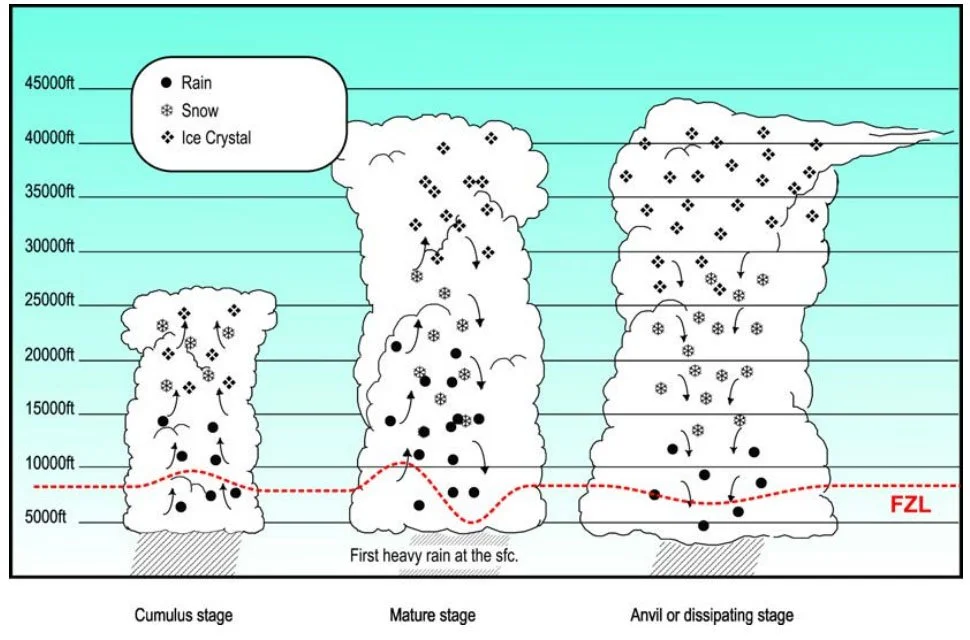Flight Safety: Dodging Thunderstorms
In the dynamic realm of aviation, thunderstorms present multifaceted challenges that every pilot must learn to navigate effectively. From powerful wind formations, severe icing, lightning strikes, and heavy precipitation to severe impacts on radio communications and maintaining altitude, these natural phenomena demand serious attention. Harnessing resources like MetFlight GA for optimal planning, coupled with critical decision-making, can significantly enhance safety and facilitate thunderstorm avoidance.
One of the less obvious, yet equally potent threats thunderstorms pose is interference with aircraft radio communications. The potent electrical activity within these weather systems can result in intense radio frequency interference. This can manifest as static, crackling noises, and even complete disruption of communication channels, making it difficult for pilots to receive clear instructions from air traffic controllers or effectively communicate their messages. As a pilot, being prepared to utilise alternative frequencies or communication protocols becomes crucial in maintaining safe and effective communication during thunderstorm encounters.
In addition to communication hurdles, thunderstorms make maintaining desired altitude an arduous task due to powerful updrafts and downdrafts. These rapid altitude changes not only challenge a pilot's ability to maintain stability but also pose the risk of aerodynamic stalls or overstressing the aircraft's structure. Further, severe turbulence accompanying thunderstorms can lead to abrupt altitude deviations, posing potential risks to unsecured passengers and equipment.
Advanced training in storm avoidance and storm penetration techniques is essential for pilots to mitigate these risks. The use of weather radar to detect and navigate around severe weather activity becomes indispensable. In cases where transiting through a thunderstorm becomes inevitable, tactics like altitude deviations or identifying regions of weaker turbulence within the storm can be instrumental in minimizing risks. Here, the role of air traffic controllers becomes invaluable, as they provide real-time weather updates and guidance to help pilots avoid hazardous weather conditions.
Image / MetService
Navigating the distinct stages of thunderstorm development is another critical skill for pilots. The initial cumulus stage, characterised by updrafts and potentially light rain, can pose an airframe icing risk due to large super-cooled liquid water droplets. As the storm matures, all hazards associated with thunderstorms may exist, with heavy precipitation and an anvil forming at the cloud's top. As the thunderstorm enters its final stage, the updrafts cease, and the hazards quickly weaken, often leaving only the anvil behind. Recognising these stages can be invaluable in avoiding inadvertent encounters with thunderstorms.
Beyond recognising thunderstorms, strategic planning is the pilot's best defense. MetFlight GA provides essential information on the timing and location of these weather systems, helping pilots decide on the necessity and safety of their flights. If the likelihood of encountering a thunderstorm is high, it is advisable to consider alternative routes or to delay or cancel the flight. Always ensure an escape plan, which might include carrying extra fuel for potential diversions.
Nevertheless, despite all the caution and preparation, encountering a thunderstorm en route can be unavoidable at times. In such situations, it's crucial to remember not to fear turning back or landing at an alternative aerodrome until the storm passes. This approach demands good pre-flight planning to ensure enough fuel for reaching an alternate aerodrome, if necessary.
In conclusion, while thunderstorms pose significant challenges, they are not insurmountable. By combining meticulous planning, constant learning, strategic decision-making, and careful adherence to safety protocols, pilots can confidently navigate these formidable weather phenomena. Always remember, in the face of unpredictable weather, "Avoid, Avoid, Avoid" is the best strategy. Your safety, and the safety of your passengers and crew, are always paramount. Log in free to MetFlight GA for up-to-date weather information to avoid thunderstorms and navigate safely in the skies. Keep learning, keep preparing, and always prioritize safety.


